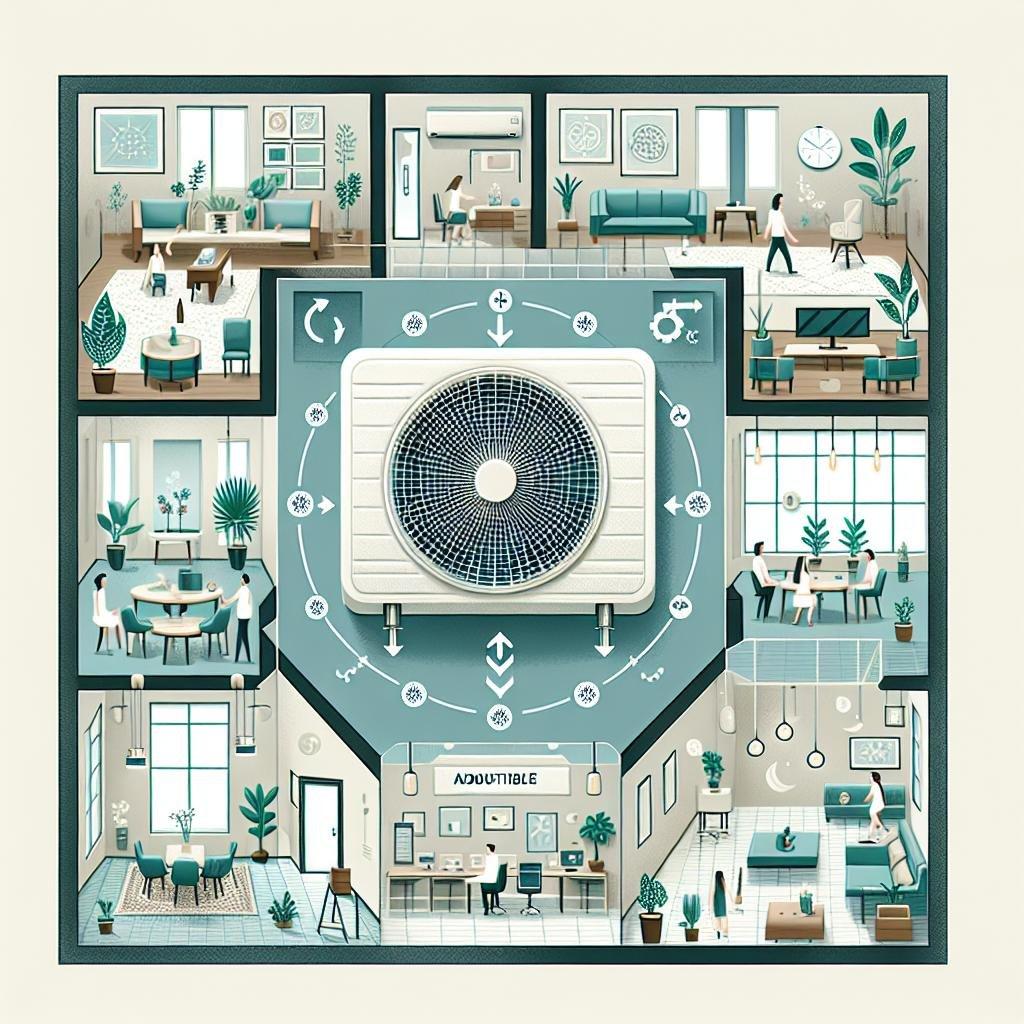As summer’s sweltering heat descends upon commercial spaces, maintaining a pleasant indoor environment becomes a priority for business owners and facility managers alike. Among the most efficient solutions to regulate temperature in diverse areas of a building is the mini split air conditioning system. These versatile units come equipped with a myriad of settings, allowing for tailored climate control that can adapt to the unique needs of various spaces-from bustling offices to serene conference rooms. In this article, we will explore the art of customizing mini split AC settings, providing you with practical insights and strategies to optimize comfort, enhance productivity, and ensure energy efficiency throughout your commercial environment. Whether you’re looking to create a welcoming atmosphere for clients or a focused workspace for employees, mastering the nuances of your mini split system can substantially elevate the experience within your commercial space.
Understanding Zoning Needs for Effective Temperature control
To achieve optimal climate control in a commercial space, it’s crucial to assess the unique zoning needs of each area. Different rooms may serve varied purposes, necessitating customized temperature settings. For instance, areas like meeting rooms may benefit from slightly lower temperatures to maintain alertness, while storage rooms may require stability to protect sensitive materials. Consider the following factors when evaluating zoning needs:
- Usage Patterns: Identify how often each area is occupied and for what purpose.
- Heat Sources: Take note of appliances, electronics, or sunlight that may impact temperature.
- Insulation Quality: Evaluate the insulation in each zone, as poorly insulated spaces may require more cooling or heating.
Understanding these elements can guide the configuration of mini split AC settings, ensuring that each zone operates efficiently without wasting energy. A well-planned zoning strategy can also enhance occupants’ comfort and productivity. Here’s a simple overview of how to allocate cooling resources based on room characteristics:
| Room Type | Recommended Temperature Setting (°F) | Cooling Priority |
|---|---|---|
| Conference Room | 68-70 | High |
| Break Room | 72-74 | Medium |
| Storage Room | 75-78 | Low |

Optimizing AC Settings for high-Traffic Areas vs. Quiet Spaces
In bustling commercial environments, understanding your space’s specific climate control needs is essential for maintaining comfort and efficiency. For high-traffic areas,such as lobbies or retail floors,your mini-split AC settings should prioritize rapid cooling with a slight bump in airflow.This ensures that the constant movement of people doesn’t heat up the space too quickly. Consider the following adjustments for these dynamic areas:
- Increased Fan Speed: Higher settings can help circulate cool air faster, accommodating the influx of warm body heat.
- Lower Temperature Setting: A cooler base temperature compensates for the warmth generated by foot traffic.
- Zone Control: If your system supports zoning, adjust the settings individually to cater to busy peaks.
Conversely, quiet spaces like offices or meeting rooms require a more subtle approach to AC settings for comfort without distraction. Here, the goal is to maintain a pleasant and consistent climate that supports productivity without a noticeable noise level. Key considerations for these areas include:
- Reduced Fan Speed: Lowering the fan speed minimizes noise levels while maintaining a steady temperature.
- Moderate Temperature setting: A comfortable mid-range temperature strikes a balance, ensuring the space is neither too cold nor too warm.
- Timer Functions: Utilize scheduling features to adjust the temperature according to use patterns, allowing for energy efficiency during off-hours.
Here’s a simple comparison of optimal settings for different areas:
| Area Type | Fan Speed | Temperature Setting | Additional Tips |
|---|---|---|---|
| High-Traffic | High | Lower | Adjust zoning features |
| Quiet Spaces | Low | Moderate | incorporate timers for efficiency |

Utilizing Timers and Schedules for Energy Efficiency
One of the most effective strategies for enhancing energy efficiency in a commercial setting is by implementing timers and schedules for your mini split AC systems. By doing so, you can tailor the operation of each unit to align with the peak occupancy hours of various areas within your space.For instance, you can program the AC to ramp up cooling before employees arrive and power down shortly after they leave, ensuring that energy is not wasted during off-hours. Such customizations can lead to considerable savings on energy bills while enhancing comfort for tenants and staff.
to effectively manage these settings,consider utilizing the following features:
- Smart scheduling: Adjust cooling times based on your unique business hours.
- Zone control: Set different temperatures for different areas to cater to varying needs.
- Remote access: Control the systems via mobile or web applications for greater versatility.
| Area | Optimal Temperature | Scheduled Operation |
|---|---|---|
| conference Room | 72°F | 8 AM – 6 PM |
| Break Room | 74°F | 9 AM – 5 PM |
| offices | 70°F | 8 AM – 5 PM |
| Reception | 73°F | 8 AM – 6 PM |
By carefully analyzing and adjusting your mini split AC settings through well-planned timers and schedules, you can significantly boost the energy efficiency of your commercial space. Not only does this approach optimize comfort for everyone occupying the premises, but it also contributes to a more sustainable environment through reduced energy consumption.

maintaining Air Quality with Custom Filter and Fan settings
To ensure optimal air quality in various areas of your commercial space, customizing the filter and fan settings of your mini split AC system is crucial. Start by choosing high-efficiency particulate air (HEPA) filters that can capture a important amount of allergens and pollutants. Consider regularly scheduled filter replacements to maintain airflow and efficacy. Adjust the fan settings to include low, medium, and high speeds, catering to different occupancy levels throughout the day. As an example:
- low Speed: Ideal for quieter times to reduce noise and energy consumption.
- Medium Speed: Perfect for moderate foot traffic where comfort and air movement are necesary.
- High Speed: Best used during peak hours to quickly refresh the air.
In addition to filter selection, monitoring and adjusting airflow direction can dramatically improve air quality. utilize the mini split’s oscillating function to distribute air uniformly, reducing cold spots and facilitating better circulation. An effective approach is to assess room layouts and zoning, using custom settings for various sections. Here’s a simple table illustrating recommended settings for different commercial spaces:
| Area | Filter Type | Fan Speed |
|---|---|---|
| Office | HEPA | Medium |
| Break Room | Activated Carbon | High |
| Conference Room | HEPA | Low |
Q&A
Q&A: How to Customize Mini Split AC Settings for Different Areas of a Commercial Space
Q1: What is a mini split AC system and why is it beneficial for commercial spaces?
A: A mini split AC system is a versatile heating and cooling solution that comprises an outdoor compressor and one or more indoor air-handling units. These systems are beneficial for commercial spaces due to thier energy efficiency, zoning capabilities, and ability to maintain individual room temperatures tailored to specific needs.This flexibility allows businesses to create a comfortable environment while optimizing energy consumption.
Q2: How can I determine the specific cooling or heating needs of different areas in my commercial space?
A: To determine the specific needs, assess each area based on factors such as size, layout, sun exposure, and function.Conference rooms may require cooler temperatures for comfort during meetings, while warehouse areas may need heating to maintain a safe working environment.Conducting a walkthrough to observe foot traffic and activity levels can also provide insights into how each space should be configured.
Q3: What are the benefits of zoning with a mini split system?
A: Zoning allows you to tailor the temperature settings and airflow in different areas according to their specific needs. This not only promotes comfort-preventing an overly warm lobby and a chilly break room-but also enhances energy efficiency, as you can avoid heating or cooling unoccupied spaces and save on utility costs.
Q4: How do I set temperature zones in my mini split system?
A: Most mini split systems come with a remote control or a smart interface that allows you to set specific temperatures for each indoor unit. Simply select the mode (cooling or heating) and adjust the temperature based on your requirements. Some systems also offer programmable schedules so you can optimize settings according to business hours.
Q5: Can I customize fan speeds for different zones in my mini split system?
A: Absolutely! Most mini split systems allow you to adjust fan speeds for each indoor unit individually. This feature can be particularly useful in larger areas where airflow needs differ. Such as, a busy area may benefit from a higher fan speed to promote airflow, while a quieter space, like an office, can be set to a lower speed for a more tranquil atmosphere.
Q6: Are ther additional features or technologies to consider when customizing mini split settings?
A: Yes, many modern mini split systems come equipped with smart technology features such as Wi-Fi connectivity, allowing remote access. This means you can adjust settings from your smartphone, ensuring that you can respond to changing occupancy levels or unforeseen conditions quickly. Look for features like programmable timers and energy-saving modes for even more customization.
Q7: How do I assess the performance of my mini split system after customization?
A: Regularly monitor the comfort levels in each zone, noted through feedback from employees and visitors. Pay attention to energy bills as well; a noticeable drop can signal effective customization. Additionally, schedule periodic maintenance checks to ensure that the system is operating efficiently and that the settings are still aligned with the space’s needs.
Q8: What are common mistakes to avoid when customizing mini split AC settings?
A: Common pitfalls include neglecting to assess individual space needs, setting all zones to similar temperatures, and using the same fan speed for different rooms. Additionally, failing to consider external factors like the weather or occupancy changes can lead to inefficient system performance. Regularly revisiting and adjusting settings can definitely help prevent these issues.
By thoughtfully customizing mini split AC settings, businesses can create a harmonious climate tailored to the varied demands of their commercial space. With the right approach, comfort, efficiency, and savings are just a few adjustments away.
Concluding Remarks
the ability to customize mini split AC settings for different areas of a commercial space is not just a luxury; it’s a necessity for optimizing comfort and efficiency. By taking into account the unique needs of each area-be it bustling offices, quiet conference rooms, or customer-facing shops-you can create a harmonious environment that enhances productivity and satisfaction. Remember, understanding your mini split system’s features and capabilities allows you to tailor the climate to your specific requirements, ensuring that every corner of your space is just the way you want it. So go ahead, embrace the art of customization and transform your commercial space into a haven of comfort, one zone at a time.

